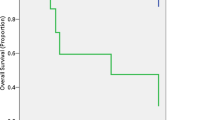Abstract
Purpose
Acetabular fractures are frequently associated with other skeletal injuries, particularly knee injuries. This study aims to evaluate the relationship between posterior acetabular fractures and knee injury, analyzing its patterns and association with other injuries.
Methods
This is a retrospective monocentric study in a tertiary referral centre. We reviewed the data (age, sex, type of fracture, and concomitant injury) of patients hospitalized for a posterior acetabular fracture. We recorded concomitant knee injury diagnosed up to one year following acetabular fracture.
Results
Two-hundred-seventeen patients (177 males/40 females) were included. The mean age was 40.5 years. Eighty-five patients (39%) had a concomitant hip dislocation, nine (4.1%) had sciatic nerve palsy, 17 (7.8%) had upper extremity injury, and 18 (8.3%) had lower extremity injury (other than the knee). Eight (3.7%) patients had spine injury, 11 (5.1%) had severe thoracic injury, nine (4.1%) had an abdominal injury, and four (1.8%) had a head injury. There were 33 (15.21%, 95% CI 10.80–20.8%) patients (30 M/3 F) (group 1) with a concomitant knee injury and 184 patients without a concomitant knee injury(group 2). The mean age in group 1 was 34.3 compared to 45.4 in group 2(p = 0.021). The pattern analysis revealed five fractures, 14 ligamentous injuries (PCL injuries = 68%), and 14 soft tissue injuries. Sixteen (48.48%) injuries were identified during hospitalization and 17 (51.51%) during follow-up. There were an association between knee injury and upper extremity injury (OR = 3.49 95% CI 1.12–10.00,p = 0.022) and other lower extremity injury (OR = 3.18 95% CI 1.03–8.95,p = 0.032).
Discussion
Knee injury is the second most frequent lesion associated with posterior acetabular fractures. Being missed in half of cases, we recommend a systematic examination of ipsilateral knees under general anaesthesia, keeping a high index of suspicion and a low threshold for complementary knee imaging. Knee injury should be mainly looked for in patients younger than 60 years and in those with upper and/or lower extremities injuries.
Similar content being viewed by others
References
Moed BR, Kregor PJ, Reilly MC, Stover MD (2017) Acetabular fractures: a problem-oriented approach. Instr Course Lect 66:3–24
Hoge S, Chauvin BJ (2019) Acetabular Fractures. In: StatPearls. StatPearls Publishing, Treasure Island
Judet R, Judet J, Letournel E (1964) Fractures of the acetabulum: classification and surgical approaches for open reduction. Preliminary report. J Bone Joint Surg Am 46:1615–1646
Letournel E (1980) Acetabulum fractures: classification and management. Clin Orthop Relat Res (151):81–106
Matta JM (1996) Fractures of the acetabulum: accuracy of reduction and clinical results in patients managed operatively within three weeks after the injury. J Bone Joint Surg Am 78:1632–1645
Schmidt GL, Sciulli R, Altman GT (2005) Knee injury in patients experiencing a high-energy traumatic ipsilateral hip dislocation. J Bone Joint Surg Am 87:1200–1204. https://doi.org/10.2106/JBJS.D.02306
Gillespie WJ (1975) The incidence and pattern of knee injury associated with dislocation of the hip. J Bone Joint Surg (Br) 57:376–378
Kempegowda H, Maniar HH, Tawari AA et al (2016) Knee injury associated with acetabular fractures: a multicenter study of 1273 patients. J Orthop Trauma 30:48–51. https://doi.org/10.1097/BOT.0000000000000425
Tabuenca J, Truan JR (2000) Knee injuries in traumatic hip dislocation. Clin Orthop Relat Res:78–83. https://doi.org/10.1097/00003086-200008000-00011
Goff AJ, Page WS, Clark NC (2018) Reporting of acute programme variables and exercise descriptors in rehabilitation strength training for tibiofemoral joint soft tissue injury: a systematic review. Phys Ther Sport 34:227–237. https://doi.org/10.1016/j.ptsp.2018.10.012
Wang D, Graziano J, Williams RJ, Jones KJ (2018) Nonoperative treatment of PCL injuries: goals of rehabilitation and the natural history of conservative care. Curr Rev Musculoskelet Med 11:290–297. https://doi.org/10.1007/s12178-018-9487-y
Spahn G, Schiltenwolf M, Hartmann B et al (2016) The time-related risk for knee osteoarthritis after ACL injury. Results from a systematic review. Orthopade 45:81–90. https://doi.org/10.1007/s00132-015-3170-4
Fok AW-M, Yau WP (2014) Associations between isolated bundle tear of anterior cruciate ligament, time from injury to surgery, and clinical tests. J Orthop Surg (Hong Kong) 22:209–213. https://doi.org/10.1177/230949901402200219
Author information
Authors and Affiliations
Corresponding author
Ethics declarations
Conflict of interest
The authors state that there is no conflict of interests. Moreover, this is a retrospective study on prospectively collected data involving humans.
Additional information
Publisher’s note
Springer Nature remains neutral with regard to jurisdictional claims in published maps and institutional affiliations.
Level of evidence: Level IV
Rights and permissions
About this article
Cite this article
Rizkallah, M., Melhem, E., Abid, H. et al. Knee injuries concomitant to posterior acetabular fractures: an association to look for. International Orthopaedics (SICOT) 45, 247–251 (2021). https://doi.org/10.1007/s00264-020-04885-3
Received:
Accepted:
Published:
Issue Date:
DOI: https://doi.org/10.1007/s00264-020-04885-3




